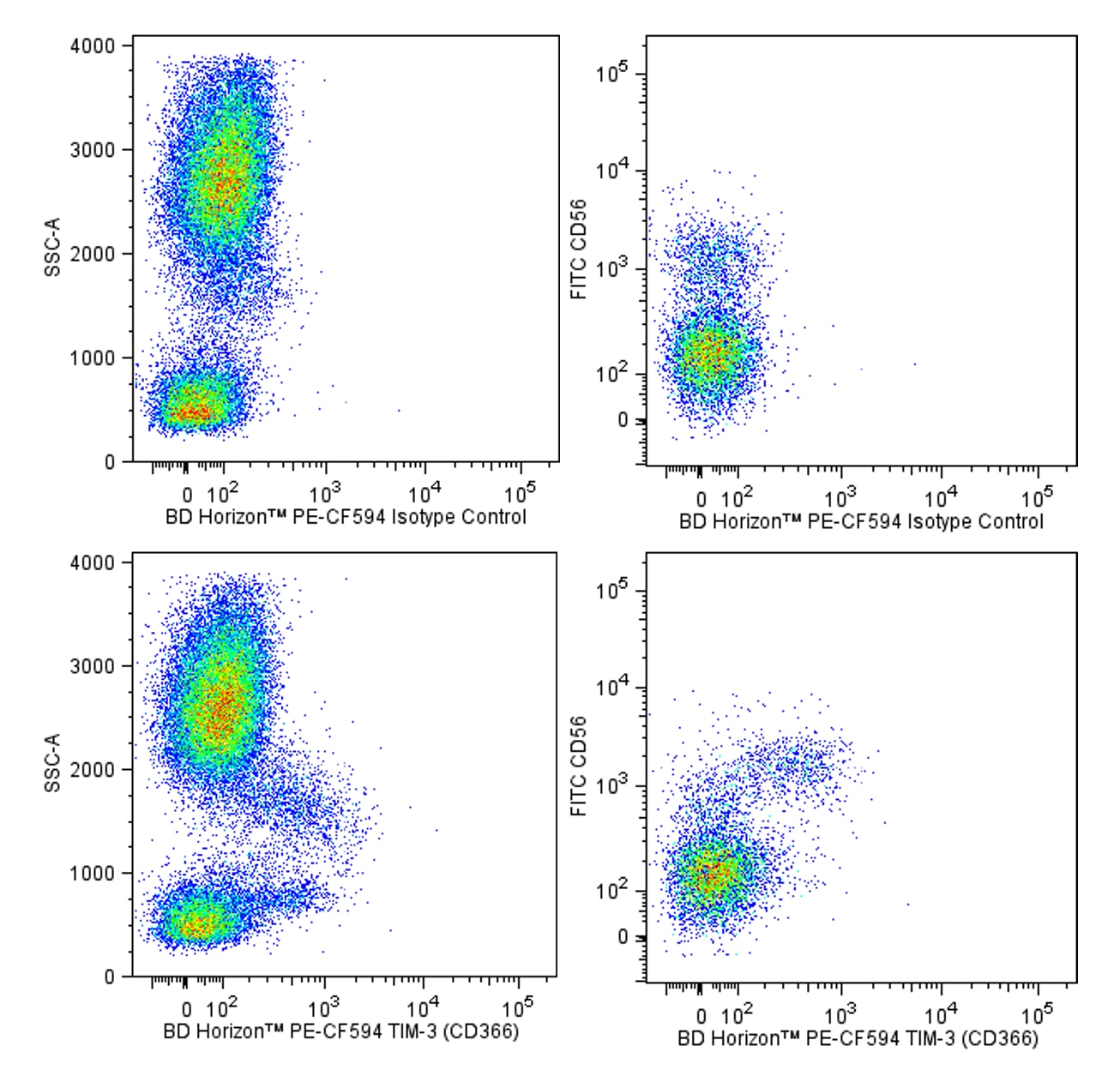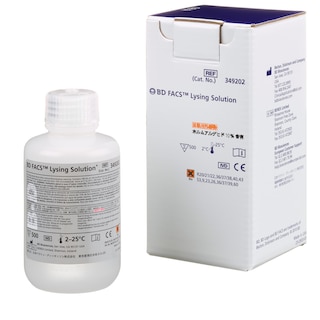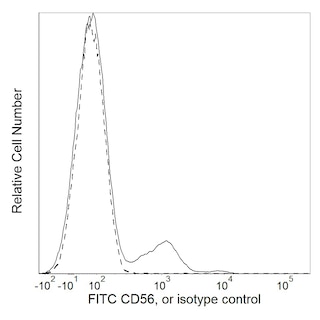-
Your selected country is
Middle East / Africa
- Change country/language
Old Browser
This page has been recently translated and is available in French now.
Looks like you're visiting us from {countryName}.
Would you like to stay on the current country site or be switched to your country?


.png)

Multiparameter flow cytometric analysis of TIM-3 (CD366) expression on human peripheral blood leucocytes. Human whole blood was stained with FITC Mouse Anti-Human CD56 antibody (Cat. No. 562794) and either BD Horizon™ PE-CF594 Mouse IgG1, κ Isotype Control (Cat. No. 562292; Top Panels) or BD Horizon PE-CF594 Mouse Anti-Human TIM-3 (CD366) antibody (Cat. No. 565560/565561; Bottom Panels). Erythrocytes were lysed with BD FACS Lysing Solution (Cat. No. 349202). Left Panels - Two-parameter flow cytometric dot plots showing the correlated expression of TIM-3 (CD366) [or Ig Isotype control staining] versus side light-scatter (SSC-A) signals were derived from gated events with the forward and side light-scatter characteristics of intact leucocyte populations. Right Panels - The two-color flow cytometric dot plots showing the correlated expression of TIM-3 (CD366) [or Ig Isotype control staining] versus CD56 were derived from gated events with the forward and side light-scatter characteristics of intact lymphocytes. Flow cytometric analysis was performed using a BD™ LSR II Flow Cytometer System.
.png)

BD Horizon™ PE-CF594 Mouse Anti-Human TIM-3 (CD366)
.png)
Regulatory Status Legend
Any use of products other than the permitted use without the express written authorization of Becton, Dickinson and Company is strictly prohibited.
Preparation And Storage
Product Notices
- This reagent has been pre-diluted for use at the recommended Volume per Test. We typically use 1 × 10^6 cells in a 100-µl experimental sample (a test).
- Please refer to www.bdbiosciences.com/us/s/resources for technical protocols.
- When excited by the yellow-green (561-nm) laser, the fluorescence may be brighter than when excited by the blue (488-nm) laser.
- Because of the broad absorption spectrum of the tandem fluorochrome, extra care must be taken when using multi-laser cytometers, which may directly excite both PE and CF™594.
- Please observe the following precautions: Absorption of visible light can significantly alter the energy transfer occurring in any tandem fluorochrome conjugate; therefore, we recommend that special precautions be taken (such as wrapping vials, tubes, or racks in aluminum foil) to prevent exposure of conjugated reagents, including cells stained with those reagents, to room illumination.
- For fluorochrome spectra and suitable instrument settings, please refer to our Multicolor Flow Cytometry web page at www.bdbiosciences.com/colors.
- CF™ is a trademark of Biotium, Inc.
- This product is provided under an Agreement between BIOTIUM and BD Biosciences. The manufacture, use, sale, offer for sale, or import of this product is subject to one or more patents or pending applications owned or licensed by Biotium, Inc. This product, and only in the amount purchased by buyer, may be used solely for buyer’s own internal research, in a manner consistent with the accompanying product literature. No other right to use, sell or otherwise transfer (a) this product, or (b) its components is hereby granted expressly, by implication or by estoppel. This product is for research use only. Diagnostic uses require a separate license from Biotium, Inc. For information on purchasing a license to this product including for purposes other than research, contact Biotium, Inc., 3159 Corporate Place, Hayward, CA 94545, Tel: (510) 265-1027. Fax: (510) 265-1352. Email: btinfo@biotium.com.
- Caution: Sodium azide yields highly toxic hydrazoic acid under acidic conditions. Dilute azide compounds in running water before discarding to avoid accumulation of potentially explosive deposits in plumbing.
- Texas Red is a registered trademark of Molecular Probes, Inc., Eugene, OR.
- An isotype control should be used at the same concentration as the antibody of interest.
- Source of all serum proteins is from USDA inspected abattoirs located in the United States.
Companion Products




.png?imwidth=320)

The 7D3 monoclonal antibody specifically binds to T cell immunoglobulin mucin 3 (TIM-3) which is also known as, CD366, or T-cell immunoglobulin and mucin domain-containing protein 3 (TIMD-3/TIMD3). CD366 is encoded by the HAVCR2 gene (Hepatitis A virus cellular receptor 2). CD366 is a type I transmembrane glycoprotein and belongs to the human TIM family (along with TIM-1 and TIM-4) within the immunoglobulin superfamily. CD366 is expressed on Th1, Tc1, Th17, Treg, NK T, and NK cells. CD366 is also expressed on dendritic cells, mast cells, monocytes, and macrophages. It is not expressed by Th2 and B cells. CD366 helps maintain peripheral immune tolerance and homeostasis. CD366 regulates macrophage activation and is a negative regulator of Th1 cell function. Crosslinking of cell surface CD366 by binding to Galectin-9 and/or phosphatidylserine appears to play an important role in either positively or negatively regulating leucocyte functions, such as cytokine production or the phagocytosis of apoptotic cells. CD366 may also be useful as an AML stem cell surface marker because it appears to be more highly expressed by AML leukemia stem cells than by normal bone marrow hematopoietic stem cells.
This antibody is conjugated to BD Horizon PE-CF594, which has been developed exclusively by BD Biosciences as a better alternative to PE-Texas Red®. PE-CF594 excites and emits at similar wavelengths to PE-Texas Red® yet exhibits improved brightness and spectral characteristics. Due to PE having maximal absorption peaks at 496 nm and 564 nm, PE-CF594 can be excited by the blue (488-nm), green (532-nm) and yellow-green (561-nm) lasers and can be detected with the same filter set as PE-Texas Red® (eg, 610/20-nm filter).

Development References (11)
-
Domenig C, Zheng XX, Sabatos CA, et al. Tim-3 inhibits T helper type 1-mediated auto- and alloimmune responses and promotes immunological tolerance. Nat Immunol. 2003; 4(11):1093-1101. (Biology). View Reference
-
Freeman GJ, Casasnovas JM, Umetsu DT, DeKruyff RH. TIM genes: a family of cell surface phosphatidylserine receptors that regulate innate and adaptive immunity.. Immunol Rev. 2010; 235(1):172-89. (Biology). View Reference
-
Hafler DA, Kuchroo V. TIMs: Central regulators of immune responses. J Exp Med. 2008; 205:2699-2701. (Biology). View Reference
-
Jan M, Chao MP, Cha AC, et al. Prospective separation of normal and leukemic stem cells based on differential expression of TIM3, a human acute myeloid leukemia stem cell marker. Proc Natl Acad Sci U S A. 2011; 108(12):5009-5014. (Biology). View Reference
-
Khademi M, Illes Z, Gielen AW, et al. T Cell Ig- and mucin-domain-containing molecule-3 (TIM-3) and TIM-1 molecules are differentially expressed on human Th1 and Th2 cells and in cerebrospinal fluid-derived mononuclear cells in multiple sclerosis. J Immunol. 2004; 172(11):7169-7176. (Biology). View Reference
-
Lee J, Su EW, Zhu C, et al. Phosphotyrosine-dependent coupling of Tim-3 to T-cell receptor signaling pathways. Mol Cell Biol. 2011; 31(19):3963-3974. (Biology). View Reference
-
Moorman JP, Wang JM, Zhang Y, et al. Tim-3 pathway controls regulatory and effector T cell balance during hepatitis C virus infection. J Immunol. 2012; 189(2):755-766. (Biology). View Reference
-
Ndhlovu LC, Lopez-Verges S, Barbour JD, et al. Tim-3 marks human natural killer cell maturation and suppresses cell-mediated cytotoxicity. Blood. 2012; 119(16):3734-3743. (Biology). View Reference
-
Rodriguez-Manzanet R, DeKruyff R, Kuchroo VK, Umetsu DT. The costimulatory role of TIM molecules. Immunol Rev. 2009; 229(1):259-270. (Biology). View Reference
-
Wang F, Wan L, Zhang C, Zheng X, Li J, Chen ZK. Tim-3-Galectin-9 pathway involves the suppression induced by CD4+CD25+ regulatory T cells. Immunobiology. 2009; 214(5):342-349. (Biology). View Reference
-
van de Weyer PS, Muehlfeit M, Klose C, Bonventre JV, Walz G, Kuehn EW. A highly conserved tyrosine of Tim-3 is phosphorylated upon stimulation by its ligand galectin-9. Biochem Biophys Res Commun. 2006; 351(2):571-576. (Biology). View Reference
Please refer to Support Documents for Quality Certificates
Global - Refer to manufacturer's instructions for use and related User Manuals and Technical data sheets before using this products as described
Comparisons, where applicable, are made against older BD Technology, manual methods or are general performance claims. Comparisons are not made against non-BD technologies, unless otherwise noted.
For Research Use Only. Not for use in diagnostic or therapeutic procedures.
Report a Site Issue
This form is intended to help us improve our website experience. For other support, please visit our Contact Us page.